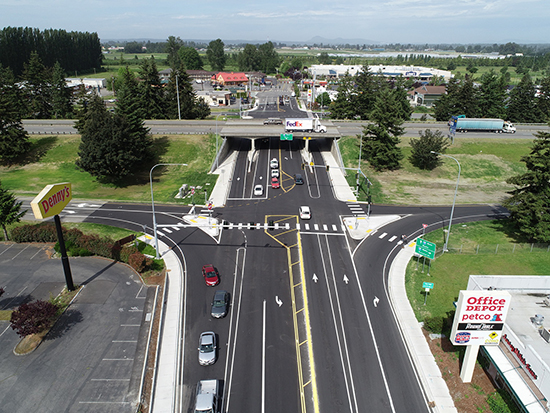|
Subscribe / Renew |
|
|
Contact Us |
|
| ► Subscribe to our Free Weekly Newsletter | |
| home | Welcome, sign in or click here to subscribe. | login |
Construction
| |
 |
May 21, 2021
Highway/Transportation $5 Million to $15 Million

College Way (SR 538) Widening
Location: Mount Vernon
General contractor: Granite Construction
The College Way widening was a technical project that presented many challenges, requiring close partnership between Granite, the city of Mount Vernon and its designer, Reichhardt & Ebe. One of the biggest challenges was accommodating the vertical grade differences. With up to 2 feet of vertical grade differences between the existing roadway profiles and the new alignment along the on/off ramps connecting I-5 to College Way, the Granite team identified public-safety risks with the original traffic control plan that ran traffic alongside and through the ramp reconstruction efforts. The team introduced a 54-hour weekend ramp closure approach that kept the traveling public safe and reduced the overall project schedule. The northbound on/off-ramps were removed, regraded and replaced in a weekend and the southbound ramp was completed in a subsequent weekend. Local stakeholders were engaged in this process to develop and implement a robust public communication strategy, significantly limiting public impacts to just two weekends versus the original month and a half of temporary traffic stages. Closures were successfully completed ahead of schedule with public buy-in on the plan. Working underneath existing I-5 bridges presented both access and stabilization challenges. Unique equipment and access were required to ensure the existing I-5 bridge was not damaged. Additionally, ground stability with a spill-through bridge abutment above the work zone, which supported I-5 traffic, was a major concern. Granite and the owner developed a settlement-monitoring plan to track changes during construction. The geotechnical report for design was drastically different than what was encountered. The ground anchor walls underneath I-5 were designed to be built in six phases on each side, alternating panels in 5-foot lifts to avoid sliding and maintain structural integrity of the base beneath I-5. However, during excavation, Granite encountered dry screened sand that would not hold the wall face, so the team quickly worked through geotechnical ideas and solutions to stabilize the dry sand in the spill through abutment area. Due to low-overhead requirements, however, conventional methods of shoring were not feasible. A cost-effective solution, called Uretek, was chosen to use polymer injection to stabilize material so that the PGA wall face could be vertically stabilized for rebar and shotcrete application. Granite, the city, Reichhardt & Ebe and WSDOT worked quickly and efficiently together to increase the finish product quality and reduce the overall schedule.
Other Stories:
- Safety: General Contractor (Building) Over 500K Worker Hours
- Heavy/Industrial $5 Million to $20 Million
- Public Building $50 Million to $100 Million
- Superintendent Of The Year
- Safety: General Contractor (Highway/Civil), Under 500,000 Worker Hours
- Heavy/Industrial Over $20 Million
- Highway/Transportation Under $5 Million
- Safety: Construction Manager Under 100,000 Worker Hours
- Construction Manager Over 400,000 Worker Hours
- Specialty Contractor Under 1 Million Worker Hours
- Safety: Specialty Contractor Over 1 Million Worker Hours
- Safety: General Contractor (Highway/Civil) Over 500,000 Worker Hours
- Safety Professional Of The Year
- Safety: General Contractor (Building) Under 100,000 Worker Hours
- Safety: General Contractor (Building) 100,000 To 200,000 Worker Hours
- Project Manager Of The Year
- Heavy/Industrial Under $5 Million
- Tenant Improvement (Public/Private)
More Than $5 Million - Grand Award: Safety
General Contractor (Building) 200,000 to 500,000 Worker Hours - Excellence In Innovation
- Private Building $5 Million To $20 Million
- Private Building Over $100 Million
- Public Building $5 Million to $20 Million
- Tenant Improvement (Public/Private) Under $5 Million
- Public Building Over $100 Million
- Public Building $20 Million to $50 Million
- Grand Award: Construction
Highway/Transportation $15 Million To $50 Million - Private Building $2 Million to $5 Million
- DBE Business Of The Year
- Champion Of Diversity Award
- Private Building $50 Million to $100 Million
- Private Building $20 Million to $50 Million
- AGC/Moss Adams Community Service Award


